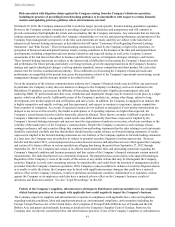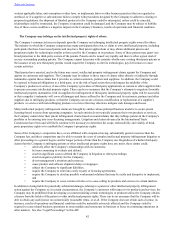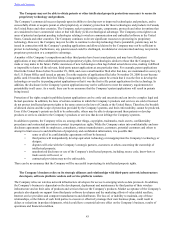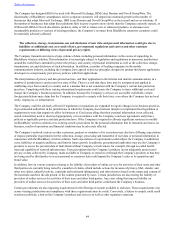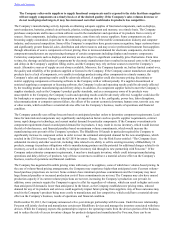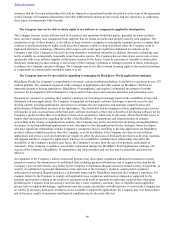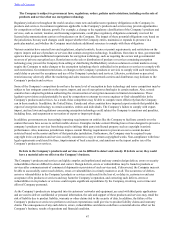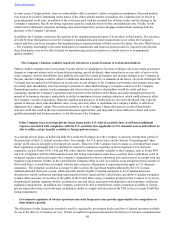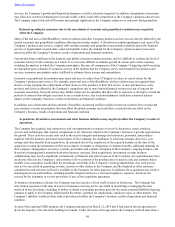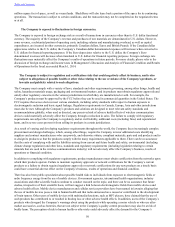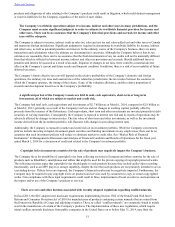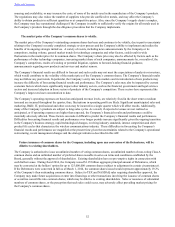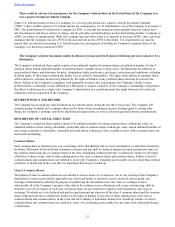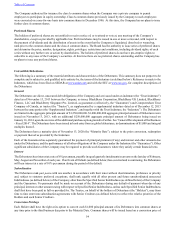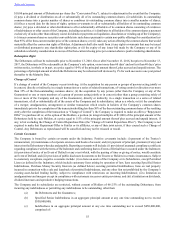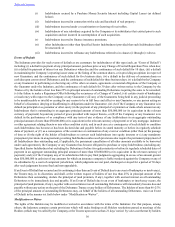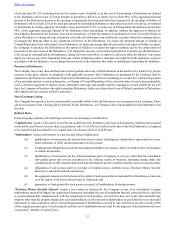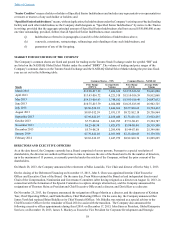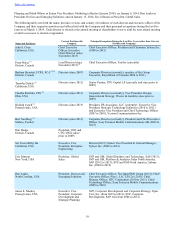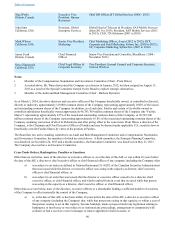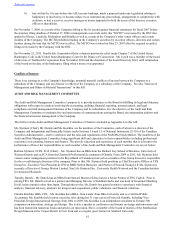Blackberry 2014 Annual Report Download - page 59
Download and view the complete annual report
Please find page 59 of the 2014 Blackberry annual report below. You can navigate through the pages in the report by either clicking on the pages listed below, or by using the keyword search tool below to find specific information within the annual report.
51
products and allegations of risks relating to the Company’s products could result in litigation, which could distract management
or result in liabilities for the Company, regardless of the merit of such claims.
The Company’s worldwide operations subject it to income, indirect and other taxes in many jurisdictions, and the
Company must exercise significant judgment in order to estimate its worldwide financial provision for income and
other taxes. There can be no assurance that the Company’s historical provisions and accruals for income and other
taxes will be adequate.
The Company is subject to income, indirect (such as sales tax, sales and use tax and value-added tax) and other taxes in Canada
and numerous foreign jurisdictions. Significant judgment is required in determining its worldwide liability for income, indirect
and other taxes, as well as potential penalties and interest. In the ordinary course of the Company’s business, there are many
transactions and calculations where the ultimate tax determination is uncertain. Although the Company believes that its tax
estimates are reasonable, there can be no assurance that the final determination of any tax audits will not be materially different
from that which is reflected in historical income, indirect and other tax provisions and accruals. Should additional taxes or
penalties and interest be assessed as a result of an audit, litigation or changes in tax laws, there could be a material adverse
effect on the Company’s current and future results and financial condition. In addition, there is a risk of recoverability of future
deferred tax assets.
The Company’s future effective tax rate will depend on the relative profitability of the Company’s domestic and foreign
operations, the statutory tax rates and taxation laws of the related tax jurisdictions, the tax treaties between the countries in
which the Company operates, the timing of the release, if any, of the valuation allowance, and the relative proportion of
research and development incentives to the Company’s profitability.
A significant portion of the Company’s assets are held in cash, cash equivalents, short-term or long-term
investments, all of which are subject to market and credit risk.
The Company had total cash, cash equivalents and investments of $2.7 billion as at March 1, 2014, compared to $2.9 billion as
at March 2, 2013, primarily as a result of the Company's net loss and net changes in working capital, partially offset by
proceeds from the issuance of the Debentures. Cash equivalents, short term and other investments are invested primarily in debt
securities of varying maturities. Consequently, the Company is exposed to interest rate risk and its results of operations may be
adversely affected by changes in interest rates. The fair value of short term and other investments, as well as the investment
income derived from the investment portfolio, will fluctuate with changes in prevailing interest rates.
Additionally, the Company is exposed to market and credit risk on its investment portfolio. While the Company’s investment
policies include investing in liquid, investment-grade securities and limiting investments in any single issuer, there can be no
assurance that such investment policies will reduce or eliminate market or credit risks. See “Market Risk of Financial
Instruments” in Management’s Discussion and Analysis of Financial Condition and Results of Operations for the fiscal year
ended March 1, 2014 for a discussion of credit risk related to the Company's investment portfolio.
Copyright levies in numerous countries for the sale of products may negatively impact the Company’s business.
The Company faces the possibility of copyright levies from collecting societies in European and other countries for the sale of
products such as BlackBerry smartphones and tablets that might be used for the private copying of copyright protected works.
The collecting societies argue that copyright levies should apply to such products because they include audio/video recording
functionality, such as an MP3 player or storage capability, despite the fact that such products are not primarily intended to act as
a recording device. If these levies are imposed, the Company’s financial results may be negatively impacted. Furthermore, the
Company may be required to pay copyright levies on products and services used by consumers to copy or stream copyrighted
works. Non-compliance with these legal requirements could result in fines, imprisonment of local executives, and sanctions on
the import and/or use of the Company’s products or services.
There are costs and other burdens associated with recently adopted regulations regarding conflict minerals.
In fiscal 2013, the SEC adopted new disclosure requirements implementing Section 1502 of the Dodd-Frank Wall Street
Reform and Consumer Protection Act of 2010 for manufacturers of products containing certain minerals that are mined from
the Democratic Republic of Congo and adjoining countries. These so-called “conflict minerals” are commonly found in metals
used in the manufacture of certain of the Company’s products. The implementation of these new regulations, which require
initial conflicts minerals disclosure from public companies in the United States on or before May 31, 2014, may limit the
Table of Contents


